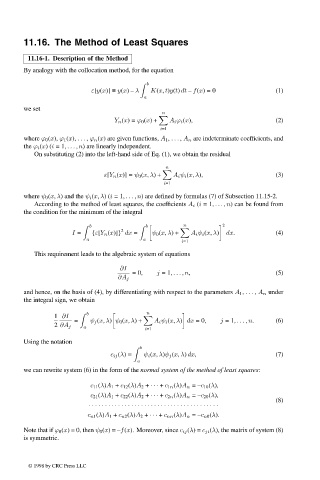Page 603 - Handbook Of Integral Equations
P. 603
11.16. The Method of Least Squares
11.16-1. Description of the Method
By analogy with the collocation method, for the equation
b
ε[y(x)] ≡ y(x) – λ K(x, t)y(t) dt – f(x) = 0 (1)
a
we set
n
Y n (x)= ϕ 0 (x)+ A i ϕ i (x), (2)
i=1
where ϕ 0 (x), ϕ 1 (x), ... , ϕ n (x) are given functions, A 1 , ... , A n are indeterminate coefficients, and
the ϕ i (x)(i =1, ... , n) are linearly independent.
On substituting (2) into the left-hand side of Eq. (1), we obtain the residual
n
ε[Y n (x)] = ψ 0 (x, λ)+ A i ψ i (x, λ), (3)
i=1
where ψ 0 (x, λ) and the ψ i (x, λ)(i =1, ... , n) are defined by formulas (7) of Subsection 11.15-2.
According to the method of least squares, the coefficients A i (i =1, ... , n) can be found from
the condition for the minimum of the integral
b b
n 2
2
I = {ε[Y n (x)]} dx = ψ 0 (x, λ)+ A i ψ i (x, λ) dx. (4)
a a
i=1
This requirement leads to the algebraic system of equations
∂I
=0, j =1, ... , n, (5)
∂A j
and hence, on the basis of (4), by differentiating with respect to the parameters A 1 , ... , A n under
the integral sign, we obtain
b n
1 ∂I
= ψ j (x, λ) ψ 0 (x, λ)+ A i ψ i (x, λ) dx =0, j =1, ... , n. (6)
2 ∂A j a
i=1
Using the notation
b
c ij (λ)= ψ i (x, λ)ψ j (x, λ) dx, (7)
a
we can rewrite system (6) in the form of the normal system of the method of least squares:
c 11 (λ)A 1 + c 12 (λ)A 2 + ··· + c 1n (λ)A n = –c 10 (λ),
c 21 (λ)A 1 + c 22 (λ)A 2 + ··· + c 2n (λ)A n = –c 20 (λ),
(8)
⋅⋅⋅⋅⋅⋅⋅⋅⋅⋅⋅⋅⋅⋅⋅⋅⋅⋅⋅⋅⋅⋅⋅⋅⋅⋅⋅⋅⋅⋅⋅⋅⋅⋅⋅⋅⋅⋅⋅⋅
c n1 (λ)A 1 + c n2 (λ)A 2 + ··· + c nn (λ)A n = –c n0 (λ).
Note that if ϕ 0 (x) ≡ 0, then ψ 0 (x)= –f(x). Moreover, since c ij (λ)= c ji (λ), the matrix of system (8)
is symmetric.
© 1998 by CRC Press LLC
© 1998 by CRC Press LLC
Page 586

